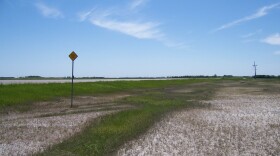I was recently flipping through Vernon Bailey’s A Biological Survey of North Dakota (Mammals) from 1926 and noticed that he made no reference to fox squirrels. So, I checked with Robert Seabloom’s Mammals of North Dakota now in its second edition. Excluding ground squirrels and the flying squirrel, Seabloom lists three species of tree squirrels, what most people would call squirrels: the Eastern gray (Sciurus carolinensis), fox (S. niger), and red squirrel (Tamiasciurus hudsonicus). The fox squirrel, of course, has a body similar to that of the gray squirrel but is a little larger and is more accurately described as orange colored rather than red.
It might surprise you, but the fox squirrel is not native to North Dakota.
An article from the Journal of Mammalogy from 1956 stated that early records of the fox squirrel in North Dakota are lacking, and that the fox squirrel likely came into North Dakota from adjacent Minnesota and South Dakota “in the last 20 years” which would put the time frame between 1936-1956.
Since that time, the fox squirrel range in the state has expanded via wooded areas along rivers and streams, as well as the planting of trees in towns and farmsteads, shelterbelts, and the like. The fox squirrel has become the most widely distributed and likely the most widely recognized tree squirrel in the state, even though documentation is lacking for some counties.
Fox squirrels can be found mainly in open woodlands, shelterbelts, parks, residential areas, and similar habitats. Their breeding season begins in January, and if all goes well a litter of 2-4 young will be born in a nest in a tree cavity during March. A later mating season may occur in the summer months.
Fox squirrels are known to consume a wide variety of items, including the seeds of many plants (particularly of trees, e.g., acorns, maple seeds, and seeds of conifers), buds, flowers, berries, tubers, roots, mushrooms, insects, and eggs. And as most everyone who has a bird feeder in their yard knows, they are also fond of dining on corn and other items in the bird feeder.





